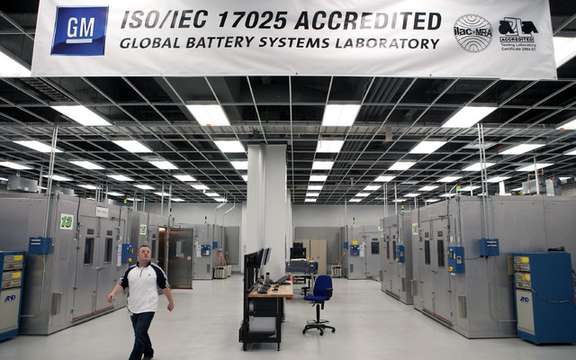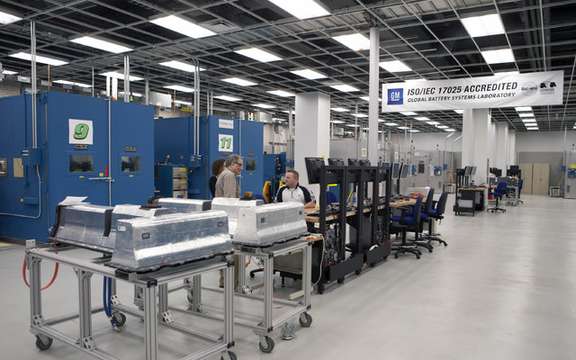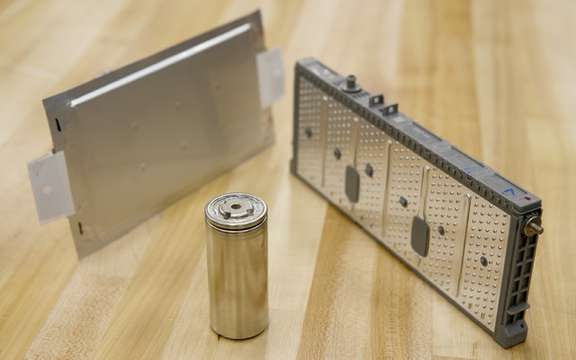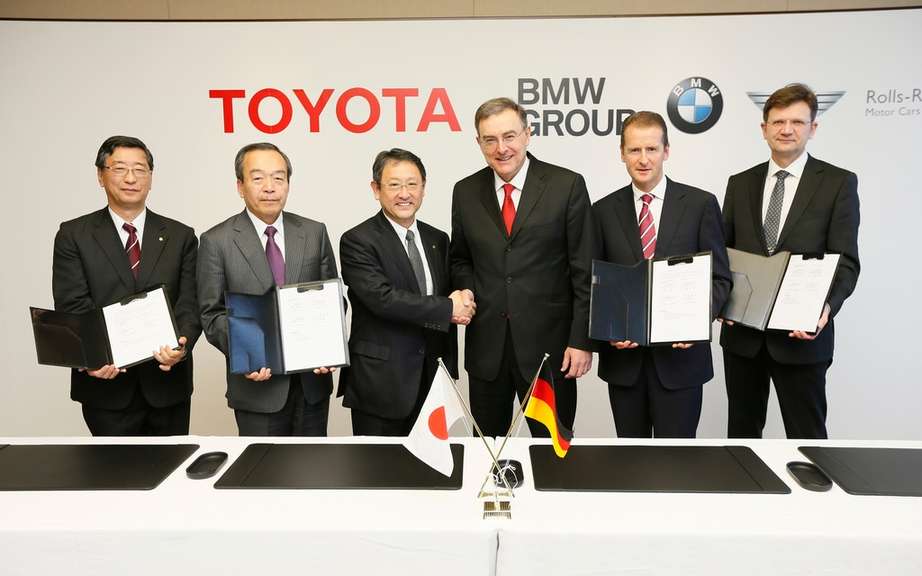GM develope its own lithium-ion
While the majority of automakers combine has productueurs developers and independent of lithium-ion or other, such as Hitachi, NEC, Toshiba and other brands, General-Motors will develop and produce its own battery and its various elements.
And here today we are told that the American Society will double the size of its laboratory development of batteries. A decision which sees the bill be elongated eight million additional area and spend 2,787 m2 5,853 m2. In fact, there is a second building to be erected at odds already existing laboratory.
The Global Battery Systens Lab is located on the campus of the GM Technical Center in Warren, Michigan, 1000 It includes engineers who put their energies to develop in parallel blocks of advanced batteries and electric vehicles that should be on our roads over the next year.
Here is the press release issued on this subject:
------------------------------------------------
Double the size of GM automotive battery lab ADVANCED
o Consolidate leadership in matters of GM technology automotive batteries and electric vehicles, like the Chevrolet Volt.
o Expansion of a $ 8,000,000 double a 5853 m?, the area of Global Battery Systems Lab located on the campus of the GM Technical Center in Warren, Michigan.
o Improves the security on site, the load tests, engineering design and manufacturing for all current and new technologies of elements, media and battery packs abilities.
WARREN (MI) - General Motors is preparing to double the size of its automotive battery lab tech to accelerate the creation of electrical vehicles.
The $ 8 million will be used to improve the testing site of all the elements, supports and blocks new and existing batteries by increasing the area of Global Battery Systems Lab Lab campus GM Technical Center of 2787 m? a 5853 m?. The addition will be located next to the existing lab, inside the Alternative Energy Center. Areas previously used for engine testing will be carefully restored and destined to the development of batteries, construction will commence this month and should be completed during the summer.
"GM is delivering on its commitment to be at the forefront of the development of electric vehicle technology, the design of the elements of the battery charging infrastructure, and investment announced today allows us to progress this sense, "said Micky Bly believes, general director of the division of international electrical systems, hybrids, electric vehicles and batteries from GM. "This addition will benefit customers by enabling us to produce cleaner and more efficient vehicles, including electric vehicle Chevrolet Volt battery life, faster and more affordable way. "
The Global Battery Systems Lab (laboratory systems worldwide batteries) GM was inaugurated in January 2009; it has reached its full capacity operating in May 2009.
The laboratory hosts a dynamic team of over 1,000 engineers from GM who perform work on advanced batteries and electric vehicles. More than half of the current lab is dedicated to testing items of electrochemical batteries and their supports. The rest of the laboratory is the evaluation of a finished blocks batteries.
The expansion will increase the capabilities in six areas, including:
* The safety and tolerance to misuse. Test powertrain used for testing engines Elements in altitude will be added after by, for testing compression, penetration, immersion in water, overload, and discharge shorting.
* The construction and dismantling. The reuse of storage space to prepare batteries before tests and provide safe rooms for the evaluation of suppliers.
* The engineering manufacturing. Reuse the space previously occupied by the engine dynamometers to improve the manufacturing processes, including laser welding and assembly of elementary cells.
* The development and integration of shippers.
* The focus thermally. Trials for radiating heat, thermal stability and thermal shock.
* Storage of batteries.
"We are committed to design, develop, validate and manufacture, a house, a car battery technology," said Mr. Bly. "Consolidating these testing capabilities at the Global Battery Systems Lab will reduce the costs, provide a competitive advantage, will speed up the pace of development and ensure that we design, build and sell the best vehicles in the world. "
The equipment and automation testing of Global Battery Systems Lab systems are in the process of integration in the global network of laboratories GM batteries, including Mainz Kastel, Germany and Shanghai, China, to facilitate exchanges of data and work sharing, transparent way.
The Global Battery Systems Lab recently deserves a global accreditation from the American Association for Laboratory Accreditation (American Association for the accreditation and certification of laboratories) homologuee by ISO, a non-governmental non-profit whose mission is to 'assess the competence and capabilities of laboratories in all fields of testing. The auditors of the organization have examined the procedures and test results, the calibration of the equipment, operating documents, the competence of the staff and the quality policy of the laboratory. Among the advantages of being a counterpart laboratory by ISO include: ensuring the accuracy of the data and the elimination of duplicate testing pricey as a result of unreliable results.
The lab is equipped with 176 test channels and 49 thermal chambers that mimic the styles of extreme driving under real conditions, extremes of temperature and lifetime of components.
This laboratory has many green features as a central vestibule acquires a LED lighting has a high efficiency and a floor made of recycled tires. Approximately 90% of the electricity used for the testing of batteries can be returned to the local power grid to supply homes and businesses. The Global Battery Systems Lab has received an honorable mention as a green project of the year of the Construction Association of Michigan.
The Global Battery Systems Lab offers other advanced equipment: a thermal shaker table for testing the structural integrity of batteries and electronic controls, an area of dismantling batteries to perform failure analysis and comparisons with the competition, an integrated system of automated testing methodology and an improved protocol of experimentation - an exercise in gathering information that allows GM to perform more extensive testing battery faster.
Furthermore laboratories batteries Warren, Mainz-Kastel and Shanghai, GM also has facilities dedicated to the construction of electric vehicles has Honeoye Falls, NY, and laboratory research in chemical engineering from the GM Technical Center.
The laboratory network batteries GM is part of the overall strategy of the company in matters of research and development on batteries, which aims to:
* Increase the capacities of development of batteries, a house, increasing the staff of the Global GM group specializes in the development of electric vehicles and advanced batteries.
* Become the first automotive manufacturer to manufacture a battery ADVANCED lithium-ion in the United States.
* Collaborate with the University of Michigan to create a new laboratory of advanced batteries for automotive Ann Arbor, Michigan, and develop a specialized engineering program at College of the University to train engineers in automotive batteries.
* Develop and grow to a solid group of battery suppliers and universities for the development and manufacture of fuel cells and integration expertise in matters of batteries, including companies such as LG Chem, A123 Systems, Hitachi Ltd.. and Compact Power Inc.
* Work with government agencies and industry consortia such as Department of Energy of the United States, the American Council for Automotive Research, the American Consortium for the development of batteries of the future and the Institute for Research in electrical energy, to accelerate the development of rechargeable and electric vehicles as well as the afferent necessary electric infrastructure.
The energies of replacement technologies and avant-garde that reduce dependence on petroleum, fuel consumption and emission are the keys to the development of sustainable transport. GM is considering several options to better meet the varied needs of its customers around the world - tech fuels, diesel and biofuels electric vehicle support, and sooner or later, has electric vehicles has autonomy and vehicles Hydrogen fuel cell. GM believes that hybrid vehicles combining energy from batteries and hydrogen fuel cells are the best long-term solution to providing sustainable personal transportation.
Factual data Global Battery Systems Lab
Place
Alternative Energy Center, GM Technical Center, Warren (MI)
Calendar
* Open area test batteries in January 2009.
* Opening the area of elements and materials testing in May 2009.
* Opening planned for phase two has been 2010.
Dimensions
Total area: 5853 m?
* Development and testing of battery packs: 1338 m?
* Development of elements and materials: 1616 m?
* Technical Support: 186 m?
* Phase two: 2787 m?
Advantage:
* Tests blocks
o 40 cyclers (test benches for batteries)
o 80 test circuits (for testing individual batteries)
o 33 thermal chambers (reproduce extreme temperature conditions)
* Testing of elements and media
o 32 cyclers
o test circuits 96
o 16 small thermal chambers
• Ability to control the environment for the correlation and reproducibility tests.
o New rooms has degree humidity control.
o New test airflow to produce a precise temperature and humidity levels to test the battery packs cooled looks benches.
o New chillers for cooling or reheating battery packs liquid cooled.
* Phase two
* Testing of safety and tolerance of a misuse.
o Elements test and test compression, penetration, immersion in water, overload, discharge and short circuit blocks, and supports of elements of batteries.
* Manufacturing Engineering.
o Testing of laser welding and development of assemblies elementary cells to improve the manufacturing process.
* Development and integration chargers.
* Tests for thermal development to radiant heat, the thermal stability and thermal shock.
View the gallery













